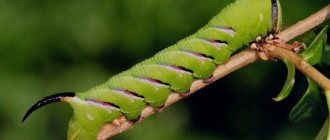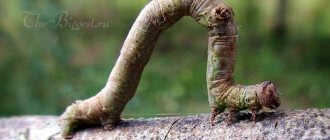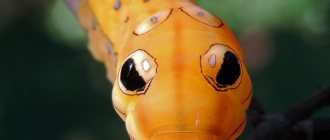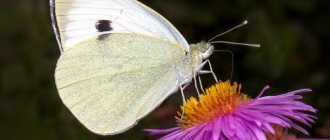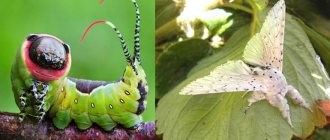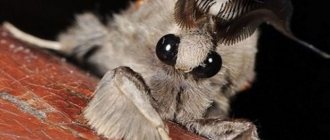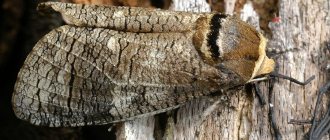Introduction
The oleander hawk moth, or oleander hawk moth (Daphnis nerii) is a butterfly from the hawk moth family (Sphingidae).
Sources
- https://BeetleStop.ru/oleandrovyiy-brazhnik/
- https://givotniymir.ru/brazhnik-babochka-obraz-zhizni-i-sreda-obitaniya-brazhnika/
- https://fb.ru/article/231109/brajnik-oleandrovyiy-interesnyie-faktyi-osobennosti-vida
- https://www.syl.ru/article/336909/krasnaya-kniga-rossii-brajnik-oleandrovyiy
- https://cicon.ru/daphnis-nerii.html
- https://wreferat.baza-referat.ru/%D0%91%D1%80%D0%B0%D0%B6%D0%BD%D0%B8%D0%BA_%D0%BE%D0%BB%D0 %B5%D0%B0%D0%BD%D0%B4%D1%80%D0%BE%D0%B2%D1%8B%D0%B9
The best flyers
Despite their apparent clumsiness and increased shaggyness, hawkmoth butterflies have earned the title of the best flyers among insects. If you observe insects in a state of immobility (when they sit), one can hardly suspect that these creatures with a fairly thick body, noticeable antennae and completely fragile wings can tear themselves off the ground.
Nevertheless, the species of butterflies of this family are unique high-speed “airplanes” from the world of insects. They are capable of reaching speeds of up to 50 kilometers per hour and can visit completely different regions in one day. Thus, insects provide themselves with a varied diet: nectar from lilacs, hydrangeas, or any other flowers - each of them has its own taste. And the hawk moth flies to this wealth purposefully, and does not just bring it with the wind, like other, lighter insects.
Habitat
Hawkmoths are common in Asia, Europe and North America. Fluffy insects that feed on nectar during the day and are nocturnal can be found from the Western European Atlantic coast to Kamchatka. Even in the most seemingly unsuitable northern regions for insect habitation, hawk moths are not uncommon.
In Russia, hawkmoth butterflies are found in the Lipetsk region, in Yelets, and in the Yamalo-Nenets Autonomous Okrug. They were photographed even near Ufa and Tyumen.
By the way, it is not so easy to capture this nimble insect, it moves so quickly from flower to flower. But in the images that were obtained, it is noticeable that the butterfly’s wings are in active motion and look transparent.
Spreading
The habitat is located in the countries of the Mediterranean basin, North Africa, Afghanistan, India, Southeast Asia, the Middle East, Sri Lanka and the Philippines. The boundaries of its range in Europe are constantly changing.
The oleander hawk moth lives mainly on the islands and coast of the Mediterranean Sea. The largest populations live in the southern regions of Greece and Italy, Sicily, Crete and Cyprus.
In 1974, butterflies were brought to the Hawaiian Islands, where they successfully acclimatized.
Oleander hawk moths are found mainly in areas with tropical and subtropical climates, oases and on mountain slopes where oleander grows.
Description of the species
Oleander hawk moth (Daphinisnerii) is a butterfly from the hawk moth family, which has more than 1 thousand species. Insects are distinguished by their love of long journeys. Scientists have not yet figured out the reason for their migration.
Imago (butterfly)
The wingspan of the insect is 100-125 mm. The massive body with a pointed belly is grassy green in color. The front wings are long - 45-50 mm, the color is a “marble” pattern of winding stripes and gradient spots of pink, white and green. There is a large purple spot near the inner edge. The hind wings are dark (black, purple or brown) at the base, becoming green at the outer edge. The two primary colors are separated by a white or yellow band.
The moth's abdomen is divided into segments by light stripes, with oblique stripes on the outer segments. The antennae are light, spindle-shaped. The head is gray or olive. The eyes are large, round, and have a complex structure. It is noteworthy that the butterfly sees well in minimal lighting.
Hawkmoth adults feed on flower nectar. They prefer fragrant plants: petunia, honeysuckle, jasmine. During the day, moths sit on trees or bushes. They become active at dusk. After sunset, butterflies flutter over the flowers, suck nectar with their proboscis and pollinate the plants.
Larva (caterpillar)
Oleander hawk moth caterpillars come in light (green) and dark (brown or beige) colors. A white stripe runs along the entire body, starting from the fourth segment, on the side. Near it on both sides there are many white dots, forming a peculiar pattern. On the third segment there are two black-blue spots with a white center. They resemble eyes. This is a protective color. In front of the enemy, the caterpillar imitates a snake. She hides her head inside her body and inflates the segment with eyes. The horny outgrowth in the back is short and curved, the color is orange. The larva has 5 pairs of legs, the pectorals are red.
The caterpillars feed on oleander, but do not disdain other plants - grapes, jasmine, periwinkle. In moments of danger, they take a threatening pose, reminiscent of the Egyptian sphinxes. Thanks to this feature, the name of the subfamily appeared - Sphinx.
In places of migration, moths form temporary colonies. Depending on the timing of the start of the flight and weather conditions, 2-4 generations develop in a new place per year. Usually the last generation does not have time to go through all stages of development before the onset of cold weather and dies. The following year, the number is restored due to the arrival of new migrating individuals.
Features and habitat
In nature there is simply an incredible amount of a wide variety of insects, beautiful and ugly, ordinary and supernatural. But, perhaps, the most popular of all this variety is the Hawk Moth butterfly.
Brazhnik wine medium
There are many legends about her. There is simply an incredible number of signs and superstitions associated with it. The butterfly Hawkmoth was given a not entirely secondary role in the popular film “The Silence of the Lambs,” in which the main character, suffering from manic tendencies, raised these moths and placed their pupae in the mouth of each of his victims.
In general, everything connected with the Hawk Moth butterfly has long been dark, mystical and frightening. For some reason, since ancient times, people have considered this moth a harbinger of disasters and always tried to destroy it when they met it.
Why do people dislike this beautiful insect so much? There are several answers to this question. One of the very first and most compelling reasons for a person’s hatred of the Hawkmoth butterfly is its appearance.
Euphorbia Hawkmoth
The fact is that on her back it’s as if someone specially drew a human skull with crossbones. Looking at such a picture, it’s unlikely that positive thoughts will come to anyone’s mind.
The second reason for people’s dislike of this insect was its unpleasant squeak. It is so loud and unpleasant, like screaming, that it makes people shudder.
A picture on the back is added to this cry and the harbinger of trouble is ready. Such external data prompted many people to create creative works in which this sweet and wonderful creature mainly acted as a monster.
At its core, this butterfly is considered one of the largest insects. The span of her beautiful wings sometimes reaches up to 14 cm. This beauty belongs to the order Lepidoptera. The body of the butterfly has the shape of a cone, its wings are narrow and elongated.
Hawkmoth cingulata
The butterfly has long antennae, round eyes and a long proboscis, which is its main assistant in obtaining food. Short and strong spines are observed on the insect's legs. Scales are visible on the abdomen. The front wings are wide and somewhat pointed towards the apex.
The rear ones are slightly smaller, sloping towards the rear. Butterfly caterpillars are large in size and have five pairs of legs. Their color is difficult to confuse with anyone else. It is bright, with diagonal stripes and spots reminiscent of eyes.
At the end of the body of the Hawkmoth butterfly caterpillar, an outgrowth of a dense structure in the form of a horn is clearly visible. In many places, these caterpillars cause harm to forestry, gardening and agriculture, damaging crops.
Death's Head Hawkmoth (Acherontia atropos)
All species of this family are comfortable in a warm environment. But among them there are also those who, for some reason, can migrate much further north from their usual habitats.
They can easily fly across seas and mountain ranges. If we look at some types of Hawk Moths, we can discern significant differences between them. The oleander hawk moth, for example, is a deep green color, like grass.
The most dangerous butterfly caterpillars
Many adult butterflies are not dangerous; caterpillars have a negative effect. Lepidoptera larvae have bright colors, villi and hairs, and are capable of releasing toxic substances. Which poisonous caterpillars are dangerous to humans?
Lonomy. Found in South America. The size of the caterpillar reaches seven centimeters. The body of the larva is dark in color, with green spines on the surface. The caterpillar secretes a substance that interferes with blood clotting.
When touching such an insect, a person may develop bleeding and problems with the kidneys. In serious cases, a cerebral hemorrhage is diagnosed; in the absence of help, negative consequences and death may develop.
Tourists often suffer from Lonomiya butterflies because they do not notice the caterpillars among the leaves of trees.
Hairy larva. This insect looks cute due to its fluffiness, and is a middle ground between a caterpillar and an adult. However, the first one is the most dangerous. The larva is small in size - up to three centimeters. The body is fluffy, brown in color and has 14 false legs. There are dangerous thorns between the hairs.
They are fragile and break quickly. Toxic substances that are dangerous to humans are released. Serious poisoning develops. If the degree of intoxication is not high, then the unpleasant sensations disappear after a day; in more serious forms, relief occurs after five days.
Caterpillars of the lacewing (golden silkworm) and mother bear are dangerous to humans. Both types of insects have hairs on their bodies that pose a danger to humans.
When touched, irritation develops on the skin and serious allergic reactions are possible. If hairs get into the eyes, the development of conjunctivitis is possible. It is recommended to remember that the bright coloring of butterflies in many cases indicates toxicity.
Pine hawkmoth
Appearance
The wingspan of the butterfly is 6.5 - 8 cm, the front wings are mouse-gray with a curved line at the top and three black lines in the center. The hind wings are brownish-gray, without a pattern. The abdomen has transverse black and light gray stripes, and a longitudinal gray stripe divided in two by a thin black line. One generation per year. Flight period: from the first half of June to the end of July, depending on the weather and climatic conditions of the area. Butterflies are active in the evening twilight, flying towards the light of street lamps. During the day they sit motionless on the trunks of coniferous trees.
Development
The female lays eggs on the underside of the leaf of the host plant. Pupation in soil, at a depth of 5 cm or in moss. An adult caterpillar is 6.5–8 cm long. The color of the body is variable, from green, with white intermittent stripes on the sides and a wide dorsal stripe of reddish-brown color, to dirty brown with weakly defined longitudinal stripes. At the posterior end of the body there is a black-brown horn. Caterpillars eat needles.
Wine Hawkmoth
Area
Widely distributed in the Palearctic, from Europe incl. The Middle and Southern Urals, through northern Turkey, northern Iran, Afghanistan, eastern Central Asia, Kazakhstan, southern Siberia to Central Yakutia, the Amur region, Primorye, Sakhalin, the Southern Kuril Islands; found in northern India, Nepal, northern Indochina, China, Korea and Japan.
Name
This hawk moth is named by scientists in honor of the mythical hero, friend of Odysseus - Elpenor. The scientific name of this elegant butterfly is sophisticated - Deilephila elpenor. The fate of Odysseus's comrade is sad: returning with the soldiers from Troy, he died absurdly, falling from the roof of the palace of the sorceress Circe. Perhaps it was the blood of a Greek youth that colored the wings of this glorious butterfly? But why is it wine? Most experts tend to consider the origin of the Russian name for this hawk moth from two points of view. Firstly, the food plant of wine hawk moth caterpillars is grapes. True, only in the southern regions. In more northern areas, where grapes do not grow, the caterpillars are quite happy with the leaves of bedstraw, loosestrife, and willowherb (fireweed). So, because of his addiction to grapes, this hawk moth would have gotten its name. The second version believes that this butterfly really seemed to have bathed in a glass of red wine. Too bright lilac-lilac-pink shades stand out in its coloring. Varieties
The wine hawk moth also has a younger brother. That’s what it’s called – the small wine hawk moth. The butterflies are very similar in color, but the small one sports even more pink “clothes”, for which it apparently received its funny Latin name - porcellus - “pig”.
Reproduction
If the summer is favorable, then the hawk moth gives two generations. The first caterpillars appear by the end of June, and the second - in August. The caterpillar of the wine hawk moth is very interesting. There are two large reddish-purple spots on the fourth and fifth segments of her body. They seem to imitate the “glasses” of the well-known cobra. And the caterpillar itself looks like a small but scary snake. This similarity is further enhanced by the fact that the first three segments, together with the head, are small in size and are easily drawn into the large fourth and fifth in case of danger. The result is a “swollen” head with scary eyes. In addition, at the end of the caterpillar’s body there is a small but strong brown horn. With such an unusual appearance and the fact that a disturbed caterpillar is capable of making sudden movements from side to side, the insect saves itself from predators.
Peculiarities
The wingspan of the largest individuals is 60-70 mm (the small wine hawk moth is noticeably smaller). Adult butterflies (imago) feed on the nectar of many of our flowers. On windless summer nights, you can watch how these beauties occasionally fly from the depths of the garden into the light of a lantern on the veranda, only to hit the lamp and rush off again to the fragrant roses and gillyflowers.
Oleander hawk moth: introduction
It is very difficult to enjoy the beauty of this butterfly. Nature has come up with the perfect camouflage for its wonderful creation. The oleander hawk moth is a fairly large nocturnal butterfly with a large wingspan. The insect's front wings measure up to 52 mm. In span they can be up to 125 mm. The front wings are painted with whitish and pink wavy stripes. The inner corner of the front wings is decorated with a large purple elongated spot.
The insect's hind wings resemble the work of an unknown artist. From the base to the middle they are painted in blackish shades, and from the center to the edge - in greenish-brown colors. The butterfly (see photo below) has color zones separated by a white stripe.
The body of the oleander beauty is elongated, sharply tapering towards the rear. The chest is colored gray-green. The abdomen has a pleasant olive color. The first abdominal segments are surrounded by a border of white hairs. Then on each side there are beveled olive stripes.
What does a caterpillar look like?
Like other members of the family, the oleander hawkmoth caterpillar is large and brightly colored. It may be green or yellowish in color. The main decorations are dark spots on both sides of the third segment. From a distance, they look like eyes, since the spot itself is blue or black, and in its center there is a white dot. Behind the third segment a light longitudinal stripe begins. The caterpillar has a short and flattened tail horn.
The caterpillar enters the pupal stage on the ground at the roots of the oleander. It weaves fragments of leaves of this plant into the cocoon. The pupa itself is brown and elongated. Each spiracle is decorated with a black spot on both sides.
Character and lifestyle of the hawk moth butterfly
There are a huge number of species of Hawkmoths living in nature. All of them lead an active lifestyle at certain times of the day: some during the day, others at night, others at dusk or early in the morning. Many of these Hawk Moth species are considered rare and are listed in the Red Book.
Hawkmoth flies very quickly, in flight it resembles a jet aircraft, which flies with a characteristic low hum. It occurs due to very frequent wing beats; the insect makes 52 beats per second.
Many species of Hawk Moths resemble small birds, such as the Oleander Hawk Hawk, the Death's Head Hawk Hawk, the Common Tongue Hawk and the Wine Hawk Hawk, and they travel great distances when migrating from continent to continent or from one end of the country to the other.
Pictured is an oleander hawk moth
Pictures with a butterfly are always bright and attractive. The hawk moth with a forewing length of 32–42 mm has a wingspan of 64–82 mm. The front wings of the butterfly are extended towards the top, have a carved edge at the bottom, and are painted brown with dark marble patterns.
Hawkmoth's back is decorated with a wide, brown stripe. The hind wings at the base of the butterfly's body are pinkish-red; against this background, large spots appear that resemble black eyes with a blue ring inside. The insect's whiskers are serrated.
The tobacco hawk moth lives in tropical regions of South America and is found as far as the northern states of the United States. It is considered a pest of tobacco plantations, since this crop is the main food of insect caterpillars. On the abdomen, this hawk moth has an interesting pattern consisting of six pairs of red and yellow squares.
In the photo there is a tobacco hawk moth
The linden hawk moth has a wingspan of 62 to 80 mm. The edges of its front wings are jagged. The color of the wings varies from olive green to reddish. Against this background, two large, irregular, often interconnected dark spots stand out.
This is interesting
Is there anything else unusual, besides the “designer” colors, in the oleander hawk moth butterfly? Entomologists revealed interesting facts during the observation process:
- All hawk moths, and the oleander species is no exception, do not sit on flowers while feeding. They hover over them, quickly moving their wings. From the outside it may seem that a hummingbird is fluttering over the flower. But hawk moths and hummingbirds are not related; these species are simply an example of convergent evolution.
- The oleander hawk moth can migrate long distances. This is facilitated by the ability to develop high speed in flight. This species of butterfly is considered the fastest among lepidopteran insects; their speed can reach 50 km/h.
- The oleander hawk moth is able to quickly pollinate a large number of flowers. This happens due to the ability to move quickly and the presence of a long proboscis.
- A rare species of butterfly, the oleander hawk moth, was listed in the Red Book of the USSR.
To maintain the population and preserve the species, scientists recommend growing oleander plantings in resort areas in order to attract the oleander hawk moth and create conditions for it to reproduce.
Area
All species of the family are heat-loving insects, but many species are active migrants and fly into territories that lie significantly north of their breeding grounds. They are able to fly across seas and mountain ranges (over 3500 m above sea level).
Types of hawk moths:
- euphorbia;
- wine;
- pine;
- hawkmoth "death's head";
- ocular;
- oleander;
- bindweed;
- lilac;
- proboscis hawk moth and others.
There are about 1,000 species of “northern hummingbirds” on the planet. Some species make long-distance flights, migrate from one end of the country to another, or cover distances between continents.
Distribution area
The oleander hawk moth is found in the natural areas of Transcaucasia, the North Caucasus, Moldova, Crimea, on the western coast of the Caspian Sea and along the entire coast of the Azov Sea.
Moreover, most often researchers can find this butterfly on the Black Sea coast in the Caucasus. The first mentions of it occur at the beginning of the 19th century. The butterfly was first described on the territory of modern Volgograd. Then it was the city of Sarepta. Entomologists noted the massive appearance of the oleander hawkmoth caterpillar. Scientists now knew exactly where this insect lived. The insect was first described on an indoor home oleander, which was placed in the garden for the whole summer.
Reproduction
Sexual dimorphism in insects is weakly expressed; males and females differ slightly in size. In the tropics, hawk moths are polycyclic species that reproduce several times a year. In the south of Russia, the basis of the population is made up of migrating insects, but even here there is time for up to three generations to change. In Abkhazia, hawk moths begin to fly at the end of May and are found until late autumn. Moths mate at dusk. After fertilization, the female lays eggs on food plants. The best option is oleander, but in its absence, grapevine, periwinkle, and fragrant tobacco will do.
The clutch lasts several days, the female lays one greenish round egg with a diameter of 1 mm. After 7-10 days, the caterpillars hatch. The newborn larva is only 3-4 mm long. It is light yellow, the horn is dark. In the first stages, nutrition occurs around the clock with a short break for rest. Young larvae prefer the leaves and flowers of the upper shoots of the oleander. During its development, the caterpillar will change five instars. The larva grows for 2-3 weeks.
Before pupation, the fifth instar caterpillar becomes darker. She descends from an oleander bush and makes a cocoon out of fragments of leaves. The pupa, 50-60 mm in size, has a lighter shell than that of other hawk moths. It is light red or brown and white. It takes 15-20 days before the young butterfly appears.
In July, a young butterfly emerges from the cocoon. She awkwardly climbs onto a vertical surface to spread her wings. After birth they are short, requiring a few minutes to return to normal. After an intensive period of feeding, females and males mate again. The next pupae appear closer to autumn; some caterpillars do not have time to pupate before the cold weather. But a cocoon lying almost on the surface of the earth does not protect it from frost and predators. The development of the pupa stops when the temperature drops to +8°; when the temperature drops below zero, it dies.
Preserving the unique creation of nature can only be done through joint efforts.
Features of development
On the Black Sea coast, in Abkhazia and in the countries of southern Europe, scientists note up to three generations of this insect. Moreover, they are periodically observed in temporary breeding areas of the species.
In our country, populations of this butterfly are mainly formed by those migrating from more southern countries. For example, in Abkhazia the first individuals appear already in May. At this time, they lay eggs, from which the first caterpillars hatch by July. Butterflies do not appear until August.
The next generation of oleander hawk moths occurs in the fall - in September or October. At the very end of the year they lay eggs. But those caterpillars that hatch in winter are simply not able to survive, so they soon die.
The following year, the population can be restored with the help of new migrants. Butterflies of this species arrive en masse from Europe. Some even reach Petrozavodsk and St. Petersburg, but rarely survive there due to the unstable and often cold climate.
Lilac Hawkmoth
Appearance
The lilac hawk moth is a very large butterfly, the size of which varies between 45-55 mm. Leads a nocturnal lifestyle. The habitat of the Lilac Hawkmoth is all of Europe up to 62° north latitude.
Many call the Lilac Hawkmoth butterfly a bird - a hummingbird because of its size and long proboscis, with which the hawkmoth sucks juice from plants. The head and abdomen of the butterfly are gray-green. The mustache is white. The hind wings are pink with a white band.
A distinctive feature of the Lilac Hawkmoth is the characteristic “marbled” pattern on the front wings. The color of the front wing pattern may vary. Wingspan - from 90 to 120 mm. Unlike most, the Lilac Hawkmoth extends its wings along the body during the resting period.
The caterpillar is particularly large in size. Can reach 11 cm in length. A characteristic feature of the Lilac Hawkmoth caterpillar is a dense horn-shaped outgrowth on the back of the body. For the development and nutrition of hawkmoth caterpillars, they choose lilac, viburnum, meadowsweet, ash, currants and grapes. Less often - other plants.
The Lilac Hawk Moth lays its eggs on the underside of the leaves, in the area of the veins. The development time of larvae is July-September months. The butterfly gives one generation. Pupae of the Lilac Hawkmoth overwinter in the soil. They are buried into the soil approximately 20-50 cm.
Spreading
The global range of the Lilac Hawkmoth is multi-regional, covering almost all of eastern, northern, southern and western (with the exception of some regions of the UK) Europe.
As for the regions of Russia, the Lilac Hawk Moth is observed in the Kaliningrad, Middle Ural, Western Caucasus, Lower Volga, Middle Amur, Kuril, Primorsky and many other regions. At the same time, the regional population is continuously growing due to migrants.
Forage plants
Viburnum, lilac, privet, meadowsweet, grapes, currants and others. As a result, plants lose their decorative properties, growth slows down, and flowering becomes poor due to extensive damage.
Features and habitat of the hawk moth butterfly
Hawk Moth is a rather large, heavy butterfly with a powerful, cone-shaped body and elongated wings, the span of which reaches 35 - 175 mm. The antennae of all Hawkmoths are long, hook-shaped, with a pointed top.
The round, open eyes of the butterfly are covered from above by scaly eyebrows. The proboscis is strong, often longer than the body. The paws are equipped with several rows of strong spines. The abdomen of the Hawk Moth is covered with scales, which are arranged at the end into a brush or wide brush.
Hawkmoth flies very quickly, in flight it resembles a jet aircraft, which flies with a characteristic low hum. It occurs due to very frequent wing beats; the insect makes 52 beats per second.
Many types of Hawk Moths
Resembling small birds such as
the Oleander Hawkmoth
, Death's Head Hawkmoth, Common Tonguehawk and Wine Hawkmoth, they cover vast distances when migrating from continent to continent or from one end of the country to the other.
Pictured is an oleander hawk moth
Pictures with a butterfly are always bright and attractive. Hawk hawk
with a front wing length of 32-42 mm, it has a wingspan of 64-82 mm. The front wings of the butterfly are extended towards the top, have a carved edge at the bottom, and are painted brown with dark marble patterns.
Hawkmoth's back is decorated with a wide, brown stripe. The hind wings at the base of the butterfly's body are pinkish-red; against this background, large spots appear that resemble black eyes with a blue ring inside. The insect's whiskers are serrated.
Tobacco Hawkmoth
lives in tropical regions of South America, found as far as the northern states of the USA. It is considered a pest of tobacco plantations, since this crop is the main food of insect caterpillars. On the abdomen, this hawk moth has an interesting pattern consisting of six pairs of red and yellow squares.
In the photo there is a tobacco hawk moth
Linden Hawkmoth
has a wingspan from 62 to 80 mm. The edges of its front wings are jagged. The color of the wings varies from olive green to reddish. Against this background, two large, irregular, often interconnected dark spots stand out.
The hind wings are orange with a dark stripe. The caterpillar of this butterfly is green with red oblique stripes on the sides; the black pupa spends the winter in the soil. Lives in deciduous forests of Europe and Western Siberia, in the gardens of Asia Minor and the Caucasus. It flies actively in early summer; sometimes a second generation of insects may appear in early autumn.
Proboscis Hawk Moth or Common Tongue
Description
The proboscis hawk moth, or common tongue hawk, is distinguished by gray front wings, on which a transverse pattern is inscribed, while the hind wings are decorated with a dark border on an orange background. The butterfly's wingspan spans up to 50 mm, and their flapping is so rapid that it is almost impossible to see them. The insect is of medium size. Its abdomen is decorated with a tassel of hairs, and it looks a bit like a bird's tail. This is why many people associate the hawk moth with hummingbirds. Butterfly caterpillars range in color from green to dark brown, however, before turning into a mature individual, the pupa turns red.
Reproduction
The insect produces offspring twice during the summer. Caterpillars of the first generation, preferring flooded areas of forest edges, appear in thickets of bedstraw and chickweed. As a rule, this occurs in early autumn (September, early October). The appearance of the second generation occurs in the summer (June, August).
Lifestyle and distribution
The common tongue is a heat-loving insect. It appears at the beginning of summer. Insects fly from the south, but representatives of the second generation fly to regions with warm climatic conditions with the autumn cold.
Insects are distributed throughout Europe, North Africa and India, Central Asia, and the Far East. In Russia, populations have been recorded in the Caucasus, Crimea, the south of the Urals and Siberia. Some individuals fly as far as Yakutsk and Syktyvkar. The proboscis prefers sunny edges, gardens, and can fly into city parks.
Description of the species
Wine hawk moth belongs to the genus Deilephila. These are large and medium-sized butterflies with a wingspan of 40-80 mm. Representatives of the species are divided into three groups based on size.
Deilephilaporcellus
Lesser wine hawk moth is widespread in the Palearctic. The wingspan of the moth is 40-55 mm. The body is pink, the front wings are yellow-olive with wide pink margins along the edge. The hind wings are pink with an ocher band. Flies in May-August. The larva is dark brown with black shading; there is no horn. Often found in southern Russia, does not migrate.
Deilephilaelpenor
Medium Wine Hawkmoth is an olive butterfly with a pink pattern. The base of the hind wings is black. Wingspan 50-70 mm. The head, chest and abdomen of the moth are olive green. The pinkish stripes on the back in the abdominal area merge into one longitudinal line. The antennae are thickened, grayish-pink. The eyes are large, complex, covered with scales. Insects have excellent vision; they see objects in low light.
Insects are common in Europe, including the south of the Urals. Found in Turkey, Iran, Central Asia, India, Korea, Japan and China. It lives in gardens, at the edge of the forest, and on roadsides. Settles on honeysuckle bushes, petunias and iris flowers. Moths living in gardens and parks pollinate 5-10% of nearby trees and shrubs.
The wine hawk moth caterpillar, as seen in the photo, can be green or dark brown, almost black in color. On the 4th-5th body segment there are round black eyes with a white border. The tail horn is short, black at the base, and the tip is white. Due to their large size (70-80 mm), the caterpillars make a terrifying impression on people. They are actually not dangerous. The larvae do not even cause serious harm to plants.
In case of danger, the wine hawk moth caterpillar is capable of inflating a segment of the body that has eyes. She draws her head in and assumes a sphinx pose, lifting her front legs off the surface. At the same time, she becomes like a snake. Given the impressive size of the body, enemies such as birds prefer not to engage in combat.
Natural areas
It is worth noting that the butterfly is also found in other latitudes. For example, in southern Europe. She regularly arrives there to leave offspring. The hawk moth can also reach even more southern countries. This is India, the northern coast of Africa, the Mediterranean states, as well as almost the entire Middle East, Iran, Turkmenistan, Iraq, and Afghanistan.
The limit to which the hawk moth can fly is determined by its physiological characteristics. The butterfly cannot withstand the cold, so it tries not to go north. Nowadays, scientists have finally decided in which natural zone the oleander hawk moth lives. It is a temperate and warm climate.
Where is this butterfly species found?
The unusual moth is not found very often. And not everyone can see it in the foliage of oleander. The oleander hawk moth is a migratory butterfly. Main places of residence - Africa and the Middle East. If the year is warm, the insect can be found in Central Europe.
In the post-Soviet space it is found in Transcaucasia, the North Caucasus, the coast of the Caspian Sea and the Sea of Azov. Most often, the oleander hawk moth comes across the Caucasian coast of the Black Sea. Sometimes a beautiful butterfly can also be seen in Moldova, Crimea and Turkmenistan. The hawk moth does not fly into cooler areas because it is physiologically unable to withstand cold winters.
Butterfly bird
For an insect, hawk moths are simply enormous in size: 29-32 mm, some individuals reach thirty-six. The wingspan of representatives of the hawk moth family is also quite large - from 50 to 70 millimeters.
Hawkmoth butterflies have a unique appearance. Each species has its own color and pattern on the back and wings. Thus, the wine hawk moth has a burgundy tint (like wine), and the butterfly with the terrifying name death's head wears an image on its back that is strikingly reminiscent of pirate symbols - a skull.
Entomologists select the names of butterflies in accordance with their inherent traits or style of behavior. The hawk moth family received its “surname” because of its habit of eating, flying from flower to flower, just as drunkards (and previously they were only called hawk moths) move from table to table, from tavern to tavern, until they have drunk enough.
Not a very euphonious name, but it is firmly attached to insects.
